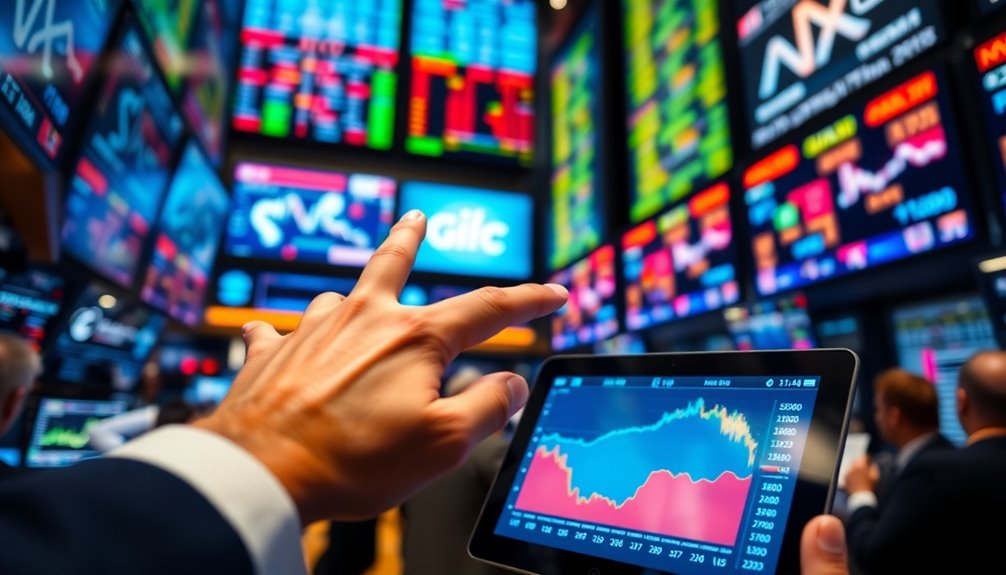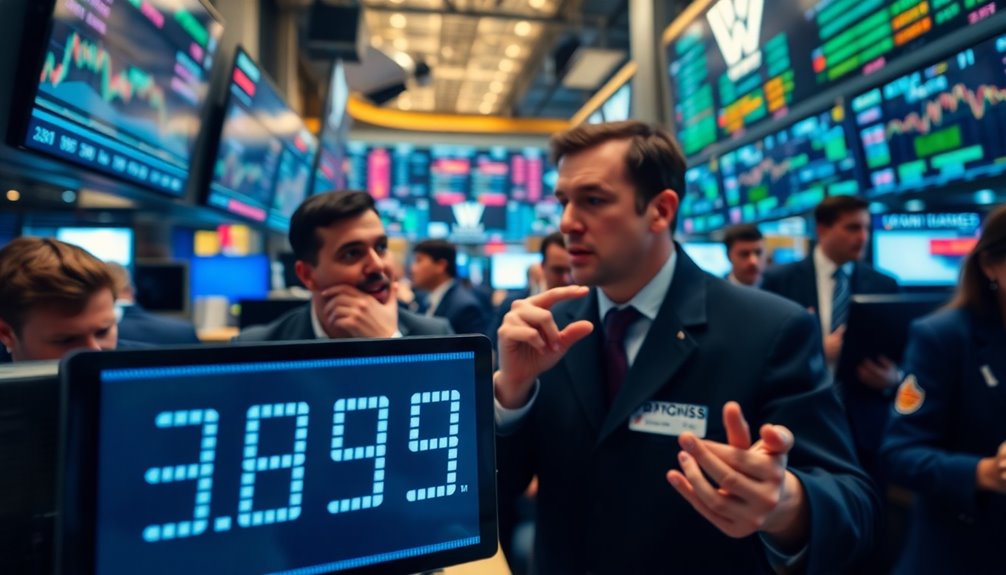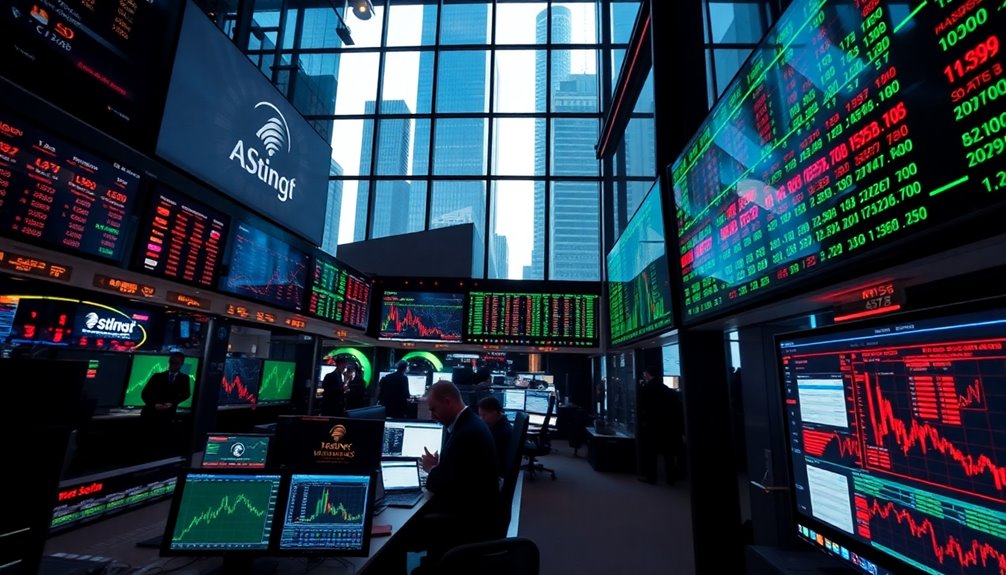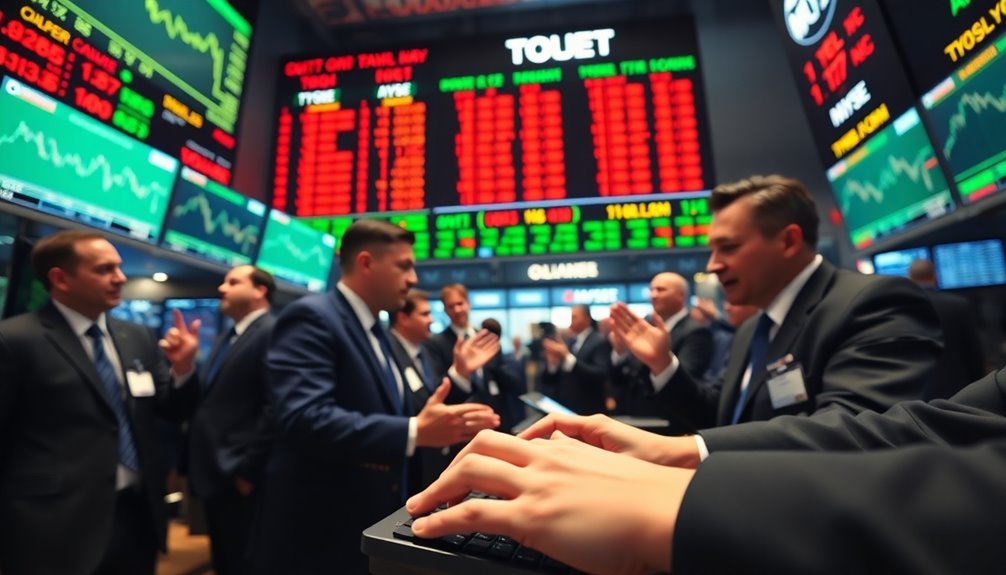Trade volume refers to the total number of shares or contracts you see traded over a specific time, showing how active a market or security is. It's vital for assessing liquidity and market sentiment. Higher trade volumes usually indicate greater interest and might signal significant price movements. Conversely, low volume can lead to slower price shifts and increased volatility. By monitoring trade volume, you can make better-informed trading decisions and spot trends. If you're curious about how to utilize volume analysis effectively, there's plenty more to uncover that can enhance your trading strategy.
Key Takeaways
- Trade volume measures the total shares or contracts traded in a specific period, reflecting market activity and liquidity.
- Higher trade volume indicates increased market interest and participation, often correlating with stronger price trends.
- Volume can signal potential reversals; high volume with rising prices suggests strong buying, while falling prices indicate selling pressure.
- Major exchanges report trade volume figures, typically displayed as vertical bars on price charts for easy analysis.
- Understanding trade volume helps investors make informed decisions regarding entry and exit strategies and market sentiment.
Trade Volume Fundamentals

Trade volume is a crucial metric in the financial world, representing the total number of shares or contracts traded within a specific timeframe. It applies to various asset types, including stocks, bonds, options, futures, and commodities. You can measure it daily or over any defined period.
Major exchanges report trading volume figures, providing insights into market activity. The calculation is straightforward: total volume equals the sum of all shares or contracts traded, ensuring no double-counting occurs. High trading volume often indicates increased market liquidity, enhancing order execution. Conversely, low volume can signal slower price movements, making it vital for you to understand these fundamentals to navigate the trading landscape effectively. Additionally, high trading volume can often correlate with rising prices, reflecting a strong balance of supply and demand.
Understanding Trade Volume Significance

Understanding the significance of trade volume is vital for making informed investment decisions. Higher trading volume typically indicates greater market liquidity, allowing for better order execution and reducing the risk of drastic price shifts. Stocks with low trading volume can face deeper corrections, while high-volume stocks are less sensitive to individual trades, making them more appealing to institutional investors. Additionally, shifts in volume can signal important price movements; high volume often accompanies significant changes, highlighting investor interest. In technical analysis, volume confirms trends and identifies reversal points. Remember, extremely low volume can attract manipulation, so always analyze sudden volume spikes carefully to avoid pitfalls. Understanding these dynamics can enhance your investment strategy and risk management, as high trading volume can lead to quicker price changes due to increased bids and offers.
Market Activity Measurement

Measuring market activity is crucial for investors looking to gauge the dynamics of their investments. Trading volume represents the number of shares or contracts traded over a specific period, calculated by summing the shares exchanged at each interval.
For instance, if 1,000 shares trade at 9:30 a.m., 2,000 at 10 a.m., and 5,000 at 3:59 p.m., the total volume reflects these transactions. This data helps traders analyze market trends, confirming genuine price movements versus deceptive shifts. High trade volumes indicate better liquidity, which is essential for executing orders effectively.
Each market exchange tracks trading volume, often displayed as vertical bars beneath price charts. High bars signal intense trading, while shorter bars indicate quieter periods. Understanding these metrics allows you to make more informed decisions regarding your investments.
Pros and Cons Analysis

Analyzing trading volume helps you weigh the benefits and drawbacks of investing in high and low volume stocks.
High volume stocks minimize volatility and narrow spreads, making it easier to buy and sell. They also confirm trends and reduce liquidity risk. However, they can attract speculation and might present false signals or overvaluation risks. Additionally, high trading volume often correlates with significant price movements, indicating strong market participation.
On the other hand, low volume stocks can offer unique opportunities for growth and lower entry points.
Yet, they're often more volatile and lack liquidity, making it tough to execute trades. Additionally, low volume may indicate uncertainty, leading to potential false breakouts. Understanding these pros and cons is crucial for making informed investment decisions.
Volume vs. Price Fluctuations

While price movements can often capture your attention, the relationship between volume and those fluctuations is equally crucial for making informed trading decisions.
High volume accompanying rising prices indicates strong buying pressure, signaling a reliable uptrend and broad market participation. Conversely, high volume with falling prices suggests significant selling pressure and reinforces a downtrend, indicating that many participants are eager to sell.
If prices rise but volume decreases, it may signal a weakening trend, hinting at a potential reversal. Additionally, stable volume alongside price movements helps you assess the sustainability of trends, whether bullish or bearish. Understanding these dynamics allows you to make more strategic decisions in your trading activities. Moreover, trading volume can signal strength or weakness of a price trend, providing further insights into market sentiment.
Market Liquidity Concerns

Market liquidity concerns play a critical role in your trading strategy, especially when navigating volatile conditions. Understanding liquidity risk is essential; it typically divides into funding liquidity and market liquidity risks.
Market liquidity measures how easily you can buy or sell an asset without drastically impacting its price. A narrow bid-ask spread indicates higher liquidity, while a wide spread suggests the opposite. Market liquidity risk can significantly impact your ability to execute trades efficiently.
Factors like market volatility and reduced activity from key participants can significantly affect liquidity. Moreover, uncertainty around monetary policy can increase volatility, leading to further liquidity challenges.
Keeping an eye on bid-ask spreads, trading volume, and funding liquidity indicators helps you gauge market conditions, allowing you to adapt your strategies effectively.
Emergence of Algorithmic Trading

As trading environments evolve, algorithmic trading has emerged as a powerful tool that transforms how traders approach the markets.
It automates the trading process using computer algorithms to make decisions and execute orders efficiently. By relying on bespoke software and mathematical formulas, it identifies trading opportunities and executes trades at precise moments, stripping emotions from the equation. This method allows you to trade 24/7 without fatigue while minimizing trading fees and ensuring efficient execution. Common strategies include trend-following, arbitrage, and TWAP or VWAP executions. Additionally, the ability to conduct backtesting capability enables traders to validate their strategies using historical data before deploying them in live markets.
Although it offers speed and accuracy, be aware of challenges like technology dependence and regulatory compliance.
Volume Analysis for Informed Trading

The rise of algorithmic trading has changed how traders analyze and interpret market data, particularly trading volume. Understanding volume is crucial; it indicates market activity levels. High volume often signals significant interest and potential trend confirmation, while low volume suggests a lack of conviction. Volume trends provide insights into investor sentiment towards a security, making it an essential aspect of technical analysis. Additionally, a solid grasp of various testing methodologies enhances your ability to analyze market data effectively.
You can utilize key indicators like On-Balance Volume (OBV) to spot trends or the Volume-Weighted Average Price (VWAP) to gauge buying pressure. Recognizing volume trends aids in making informed trading decisions, especially during breakouts or reversals.
Pay attention to sudden volume spikes, as they often precede major price moves. By leveraging volume analysis, you can enhance your trading strategies and better understand market sentiment, leading to more informed trading choices.
Frequently Asked Questions
How Is Trade Volume Calculated for Different Asset Classes?
To calculate trade volume for different asset classes, you first identify the timeframe, like a day or week.
For stocks, you count each buy and sell transaction. In options and futures, you tally the contracts traded. For bonds, you count the bond units exchanged.
You can find this data on trading platforms or financial news sites. Ultimately, high volumes reflect active trading and better liquidity, while lower volumes indicate less market activity.
Can Trade Volume Predict Market Trends Effectively?
Imagine you're standing in a bustling marketplace, where the chatter of buyers and sellers fills the air.
Trade volume can indeed predict market trends effectively. When you see high trading volume, it signals strong market participation and confirms the trend's strength.
Conversely, if you notice rising prices with falling volume, it might hint that momentum's fading.
Paying attention to these patterns helps you make informed trading decisions and navigate market sentiment more confidently.
What Tools Are Best for Analyzing Trade Volume Data?
To analyze trade volume data effectively, you should consider using tools like Quantower and NinjaTrader for volume distribution analysis.
They provide customizable volume profiles and visualization modes. For real-time insights, Bookmap and NinjaTrader's order flow analysis tools help you visualize incoming buy and sell orders.
Additionally, using heatmaps and liquidity maps can reveal market dynamics, while statistical tools offer detailed breakdowns of trade sizes and volume comparisons.
How Does Trade Volume Differ Between Exchanges?
Trade volume can differ significantly between exchanges due to various factors like reporting methods and market activity.
You'll notice some exchanges have stricter reporting standards, leading to more accurate volume figures. Additionally, higher average volumes often indicate better liquidity, which affects order execution.
Regional or sector-specific trends can also influence volume patterns, making it essential for you to consider these differences when analyzing potential trading opportunities across exchanges.
What Role Does News Play in Influencing Trade Volume?
News is like a siren call, drawing investors to the shores of trading activity. When a major story breaks, you can bet trading volume will surge as curiosity piques interest.
Whether it's a CEO's indictment or an earnings announcement, the buzz can spark a flurry of trades.
You'll find that local media coverage can amplify this effect, increasing your trading opportunities and shaping market movements in real-time.
Conclusion
In the dynamic world of trading, understanding trade volume is like holding the key to a treasure chest. It reveals not just the heartbeat of the market, but also the whispers of potential opportunities. While high volume can signal excitement, low volume often hints at caution. By mastering volume analysis, you can navigate the thrills and spills of trading, making informed decisions that balance risk and reward. Embrace the dance of volume and price, and let it guide your strategy.









